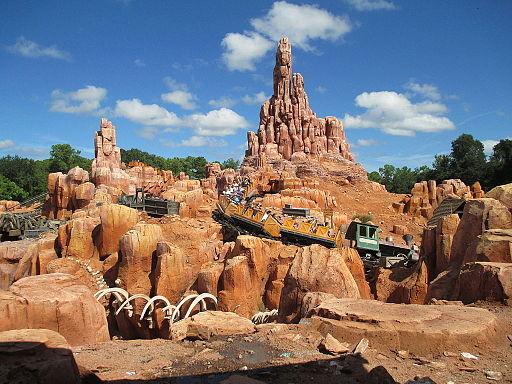Scientific research, folks in white lab coats, gleaming laboratories, occasional Eureka moments interspersed with hours of work – still sounds interesting if not glamorous. But sometimes, science requires more dedication, more sacrifice. Two physicians made the effort studying the effect of Thunder Mountain, a Disney World roller coaster, on kidney stones – small crystals that form in your kidneys.
The study
The authors built a 3-D model of a kidney and ureter, the anatomic tube that connects the kidney to the bladder. The model faithfully recreated the kidney's "collection system," the pathway a kidney stone takes as it follows urine out of the body. They wanted to know whether these crystals or stones would move because of outside forces, like those you might experience on a roller coaster. Three different size kidney stones were placed in three different locations within the kidney; then, securing the model in a backpack the authors rode Thunder Mountain twenty times. Thunder Mountain is a roller coaster ride of two and half minutes at about 35 miles per hour with all the curves and dips you would associate with such a ride.
- 17% of stones moved when the model rode in the front of the ride; larger stones moved the most
- 64% of stones moved when the model rode in the back of the coaster; all sizes moved to the same degree
- Stones that began at the top of the kidney's collection system moved the most, those at the bottom, presumably fighting gravity, moved the least.
Kidney stones
The only way for these crystals to get out of the kidney is through urination, and the passageway through the kidney's collection system narrows as the kidney connects to the ureter. The ureter is about 3-4mm in diameter. Stones of that size or smaller usually pass without symptoms, but larger stones get stuck and can create a great deal of pain as your body tries to push them out. The pain that results is terrible, severe enough to send 1 million patients a year to the emergency department. And opioids are the only real source of relief, no acupuncture or acetaminophen for this pain, termed renal colic.
Gout and family history are traditional risk factors, and more recently the formation of kidney stones has been found increased in obesity and diabetes. Kidney stones form (actually they crystallize) because of disturbances in our metabolism of calcium and oxalate, which compose the crystals found in most stones, as well as sluggish urine flow because of dehydration or for mechanical, anatomic reasons. The incidence is reported to be about 9% of the population; Because the cause is most frequently metabolic, upwards to 50% of patients suffered recurrences if not treated.
Long-term treatment includes increasing fluid intake to more than a liter daily and avoiding calcium supplement. Interestingly enough, dietary calcium, the calcium contained in our food has not been shown to increase risk; it actually lowers risk. So much for supplements.
"Cutting for stone," shock waves and rollercoasters
Acute treatment is based on symptoms and stone size. Eighty percent of stones that are 4 mm or smaller, the size of the ureter, pass without further intervention. But passage diminishes rapidly as the size grows, a 6 mm stone passes only 20% of the time. The largest stone in the study 13 mm passes less than 1% of the time.
Stones that do not pass are most often removed. “Cutting for stone” has a long history. It is expressly prohibited in the Hippocratic Oath, requiring the cutting to be done by other practitioners, not physicians. (So we see that the schism between surgeons and internists is quite old, antedating the disparities we see in their payments today.) But actual surgery (the cutting to remove stones) has mainly been replaced by newer technologies, particularly extracorporeal shock wave lithotripsy (ESWL). Do not let the name frighten you; it is simply shock waves passed through your body that break up the stones into passable smaller pieces. Knowing that shock waves are used to treat stones makes it a bit more understandable why the physicians wanted to study the effect of roller coasters.
The authors conclude their study pointing out that riding in the rear car of the roller coaster “might facilitate fragment passage” and with these clinical suggestions
“Once a patient has passed a renal calculus, regular riding on a moderate-intensity roller coaster may facilitate microscopic and very small (i.e., the size of a grain of sand) calculi passage before symptomatic renal calculi can recur. Women with small renal calculi who are planning to become pregnant should consider riding moderate-intensity roller coasters before starting calcium and vitamin D supplements with prenatal vitamins to reduce the risk of complications from renal calculi in pregnancy.”
The average cost for ESWL is $17,400 (although if you have suffered the pain of a kidney stone, you know this is money well spent). Looking for a bargain? Similar care in India along with a two-week stay for two will run you about $800 for the procedure and $5600 for your stay as a medical tourist. By comparison, a day at Disney World for you and the family should run about $500 with another $500 or so for lodging and incidentals.
Source: Validation of a Functional Pyelocalyceal Renal Model for the Evaluation of Renal Calculi Passage While Riding a Roller Coaster Journal of the American Osteopathic Association doi:10.7556/jaoa.2016.128




